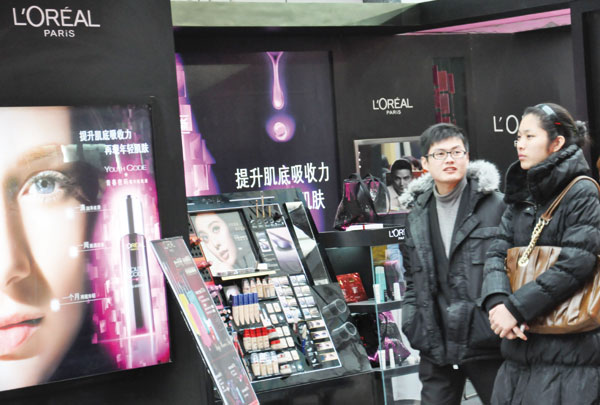L'Oreal scents success despite slowed growth
Updated: 2013-03-01 12:20
By Xu Junqian in Shanghai (China Daily)
|
||||||||
|
 |
|
Shoppers walk along a L'Oreal sales center at a shopping mall in Qingdao, Shandong province. [Photos/China Daily] |
L'Oreal, the world's largest cosmetics and beauty company, has recorded its 12th consecutive year of double-digit growth in China, reaping 12.05 billion yuan ($1.91 billion) in revenue in 2012.
But the revenue growth rate dropped from 18 percent in 2011 to 12.4 percent last year in China, the third-largest market for L'Oreal, which harbors ambitions to gain more than 1 billion new consumers in the next decade, mostly from emerging markets.
Alexis Perakis-Valat, CEO of L'Oreal China, attributed the drop in growth rate to the general cosmetics market in China, which has been increasing less rapidly and to the "big base" the French company has achieved since arriving in 1997.
"We are very happy to close 2012 with a year of solid and healthy growth," said Perakis-Valat. "And we are very confident and ambitious of continuing to grow faster than the market."
He said growth in China is happening, and will continue to do so, particularly in lower-tier cities, and in cosmetics and men's skincare.
A global beauty survey by Elle magazine in January found Asian women are among the biggest spenders on cosmetics, especially those between the ages of 25 and 34.
For example, 46 percent of Chinese mainland women use moisture masks several times a week, more than anywhere else in the world. But they use half as many lipsticks as their counterparts in Hong Kong.
"There is still a lot of education to do about wearing cosmetics and UV blocks," Perakis-Valat said.
Other cosmetics and beauty companies have also been eying the China market and been making significant moves.
Procter & Gamble, for example, has launched four new brands in China in recent months, while Estee Lauder is planning to introduce a new brand, Osiao, to the country, exclusively tailored for Asian skins.
At the same time, the central government is introducing policies to support Chinese cosmetics and beauty product makers.
The market share of international cosmetics and beauty companies in China has been dropping, from around 60 percent in 2009 to less than 45 percent in 2012, according to statistics from Nielsen.
But this is not the case for L'Oreal, which now has 14 percent of the market share in China.
"L'Oreal was able to grow faster than the market and to gain market share again," said Perakis-Valat, adding that growth was across all four divisions of the company - consumer, luxury and professional products and active cosmetics.
The company, which operates a portfolio of 20 cosmetics brands in China including Lancome, Kiehl's and Yue-Sai, is looking to introduce more brands into the world's second-largest market for cosmetics, after the United States.
Several weeks ago, L'Oreal China brought to first-tier cities, including Beijing, Shanghai and Guangzhou, a sonic facial cleanser from Clarisonic, a US brand acquired by the French company at the end of 2011.
"We will keep launching game-changing products of this kind in China," he added.
xujunqian@chinadaily.com.cn

 Li Na on Time cover, makes influential 100 list
Li Na on Time cover, makes influential 100 list
 FBI releases photos of 2 Boston bombings suspects
FBI releases photos of 2 Boston bombings suspects
 World's wackiest hairstyles
World's wackiest hairstyles
 Sandstorms strike Northwest China
Sandstorms strike Northwest China
 Never-seen photos of Madonna on display
Never-seen photos of Madonna on display
 H7N9 outbreak linked to waterfowl migration
H7N9 outbreak linked to waterfowl migration
 Dozens feared dead in Texas plant blast
Dozens feared dead in Texas plant blast
 Venezuelan court rules out manual votes counting
Venezuelan court rules out manual votes counting
Most Viewed
Editor's Picks

|

|

|

|

|

|
Today's Top News
Boston bombing suspect reported cornered on boat
7.0-magnitude quake hits Sichuan
Cross-talk artist helps to spread the word
'Green' awareness levels drop in Beijing
Palace Museum spruces up
First couple on Time's list of most influential
H7N9 flu transmission studied
Trading channels 'need to broaden'
US Weekly

|

|







